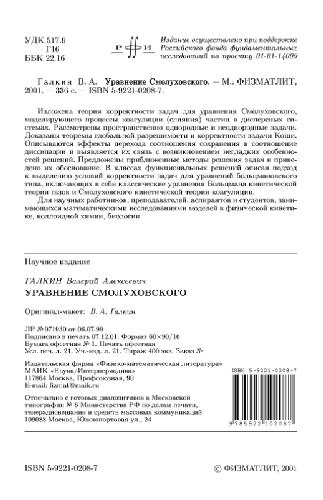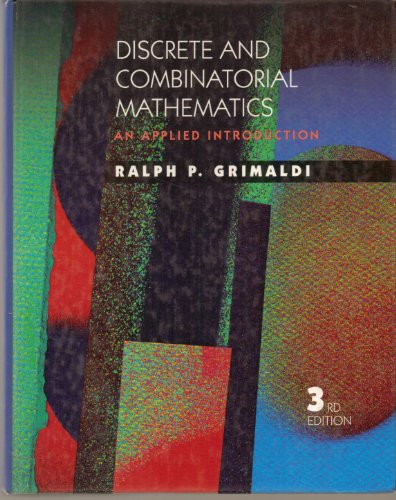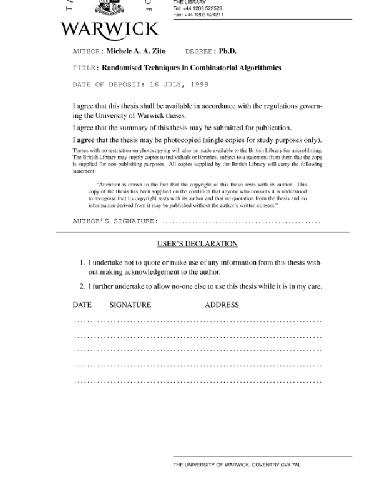Dominic Jordan, Peter Smith978-0-19-920824-1, 978-0-19-920825-8
Table of contents :
Contents……Page 4
Preface to the fourth edition……Page 8
1.1 Phase diagram for the pendulum equation……Page 10
1.2 Autonomous equations in the phase plane……Page 14
1.3 Mechanical analogy for the conservative system x=f(x)……Page 23
1.4 The damped linear oscillator……Page 30
1.5 Nonlinear damping: limit cycles……Page 34
1.6 Some applications……Page 41
1.7 Parameter-dependent conservative systems……Page 46
1.8 Graphical representation of solutions……Page 49
Problems……Page 51
2.1 The general phase plane……Page 58
2.2 Some population models……Page 62
2.3 Linear approximation at equilibrium points……Page 66
2.4 The general solution of linear autonomous plane systems……Page 67
2.5 The phase paths of linear autonomous plane systems……Page 72
2.6 Scaling in the phase diagram for a linear autonomous system……Page 81
2.7 Constructing a phase diagram……Page 82
2.8 Hamiltonian systems……Page 84
Problems……Page 88
3.1 The index of a point……Page 98
3.2 The index at infinity……Page 106
3.3 The phase diagram at infinity……Page 109
3.4 Limit cycles and other closed paths……Page 113
3.5 Computation of the phase diagram……Page 116
3.6 Homoclinic and heteroclinic paths……Page 120
Problems……Page 122
4.1 An energy-balance method for limit cycles……Page 134
4.2 Amplitude and frequency estimates: polar coordinates……Page 139
4.3 An averaging method for spiral phase paths……Page 143
4.4 Periodic solutions: harmonic balance……Page 147
4.5 The equivalent linear equation by harmonic balance……Page 149
Problems……Page 152
5.1 Nonautonomous systems: forced oscillations……Page 158
5.2 The direct perturbation method for the undamped Duffing’s equation……Page 162
5.3 Forced oscillations far from resonance……Page 164
5.4 Forced oscillations near resonance with weak excitation……Page 166
5.5 The amplitude equation for the undamped pendulum……Page 168
5.6 The amplitude equation for a damped pendulum……Page 172
5.7 Soft and hard springs……Page 173
5.8 Amplitude–phase perturbation for the pendulum equation……Page 176
5.9 Periodic solutions of autonomous equations (Lindstedt’s method)……Page 178
5.10 Forced oscillation of a self-excited equation……Page 180
5.11 The perturbation method and Fourier series……Page 182
5.12 Homoclinic bifurcation: an example……Page 184
Problems……Page 188
6.1 Non-uniform approximations to functions on an interval……Page 192
6.2 Coordinate perturbation……Page 194
6.3 Lighthill’s method……Page 199
6.4 Time-scaling for series solutions of autonomous equations……Page 201
6.5 The multiple-scale technique applied to saddle points and nodes……Page 208
6.6 Matching approximations on an interval……Page 215
6.7 A matching technique for differential equations……Page 220
Problems……Page 226
7.1 General forced periodic solutions……Page 232
7.2 Harmonic solutions, transients, and stability for Duffing’s equation……Page 234
7.3 The jump phenomenon……Page 240
7.4 Harmonic oscillations, stability, and transients for the forced van der Pol equation……Page 243
7.5 Frequency entrainment for the van der Pol equation……Page 248
7.6 Subharmonics of Duffing’s equation by perturbation……Page 251
7.7 Stability and transients for subharmonics of Duffing’s equation……Page 256
Problems……Page 260
8 Stability……Page 268
8.1 Poincaré stability (stability of paths)……Page 269
8.2 Paths and solution curves for general systems……Page 274
8.3 Stability of time solutions: Liapunov stability……Page 276
8.4 Liapunov stability of plane autonomous linear systems……Page 280
8.5 Structure of the solutions of n-dimensional linear systems……Page 283
8.6 Structure of n-dimensional inhomogeneous linear systems……Page 288
8.7 Stability and boundedness for linear systems……Page 292
8.8 Stability of linear systems with constant coefficients……Page 293
8.9 Linear approximation at equilibrium points for first-order systems in n variables……Page 298
8.10 Stability of a class of non-autonomous linear systems in n dimensions……Page 302
8.11 Stability of the zero solutions of nearly linear systems……Page 307
Problems……Page 309
9.1 The stability of forced oscillations by solution perturbation……Page 314
9.2 Equations with periodic coefficients (Floquet theory)……Page 317
9.3 Mathieu’s equation arising from a Duffing equation……Page 324
9.4 Transition curves for Mathieu’s equation by perturbation……Page 331
9.5 Mathieu’s damped equation arising from a Duffing equation……Page 334
Problems……Page 339
10.1 Introducing the Liapunov method……Page 346
10.2 Topographic systems and the Poincaré–Bendixson theorem……Page 347
10.3 Liapunov stability of the zero solution……Page 351
10.4 Asymptotic stability of the zero solution……Page 355
10.5 Extending weak Liapunov functions to asymptotic stability……Page 358
10.6 A more general theory for autonomous systems……Page 360
10.7 A test for instability of the zero solution: n dimensions……Page 365
10.8 Stability and the linear approximation in two dimensions……Page 366
10.9 Exponential function of a matrix……Page 374
10.10 Stability and the linear approximation for nth order autonomous systems……Page 376
10.11 Special systems……Page 382
Problems……Page 386
11.1 The Poincaré–Bendixson theorem and periodic solutions……Page 392
11.2 A theorem on the existence of a centre……Page 399
11.3 A theorem on the existence of a limit cycle……Page 403
11.4 Van der Pol’s equation with large parameter……Page 409
Problems……Page 412
12.1 Examples of simple bifurcations……Page 414
12.2 The fold and the cusp……Page 416
12.3 Further types of bifurcation……Page 420
12.4 Hopf bifurcations……Page 428
12.5 Higher-order systems: manifolds……Page 431
12.6 Linear approximation: centre manifolds……Page 436
Problems……Page 442
13.1 Poincaré sequences……Page 448
13.2 Poincaré sections for nonautonomous systems……Page 451
13.3 Subharmonics and period doubling……Page 456
13.4 Homoclinic paths, strange attractors and chaos……Page 459
13.5 The Duffing oscillator……Page 462
13.6 A discrete system: the logistic difference equation……Page 471
13.7 Liapunov exponents and difference equations……Page 475
13.8 Homoclinic bifurcation for forced systems……Page 478
13.9 The horseshoe map……Page 485
13.10 Melnikov’s method for detecting homoclinic bifurcation……Page 486
13.11 Liapunov exponents and differential equations……Page 492
13.12 Power spectra……Page 500
13.13 Some further features of chaotic oscillations……Page 501
Problems……Page 503
Answers to the exercises……Page 516
A: Existence and uniqueness theorems……Page 520
B: Topographic systems……Page 522
C: Norms for vectors and matrices……Page 524
D: A contour integral……Page 526
E: Useful results……Page 527
References and further reading……Page 530
C……Page 534
E……Page 535
I……Page 536
L……Page 537
P……Page 538
S……Page 539
Z……Page 540








Reviews
There are no reviews yet.